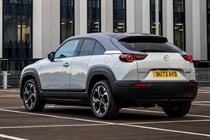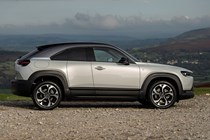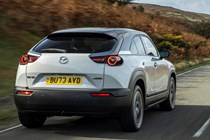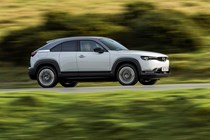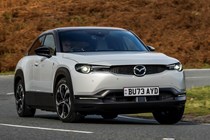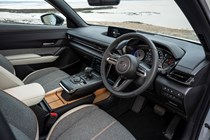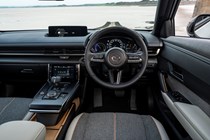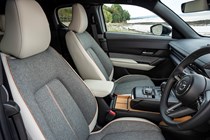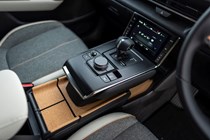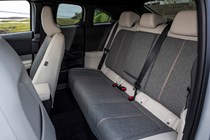
Mazda MX-30 R-EV long-term test
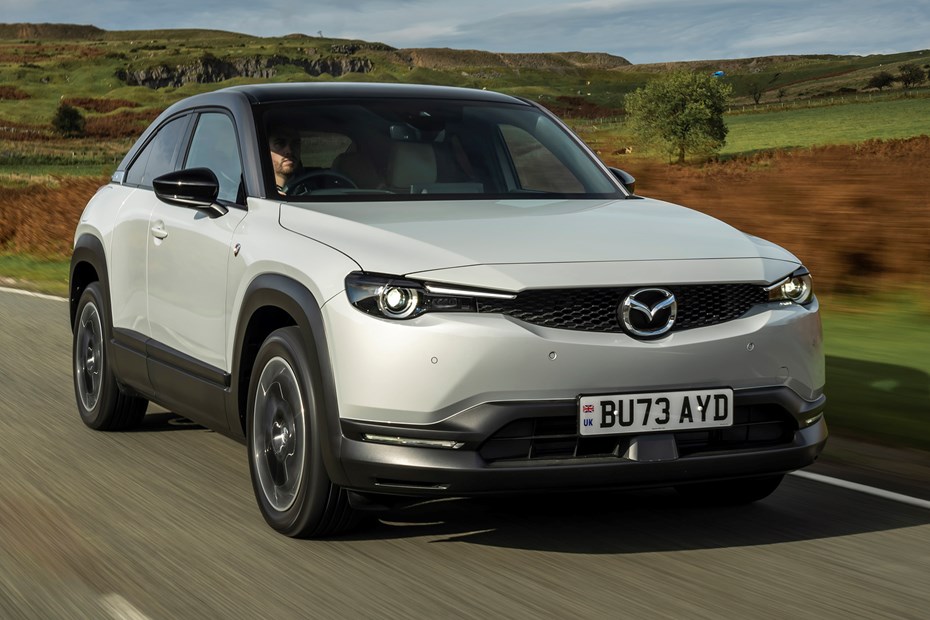
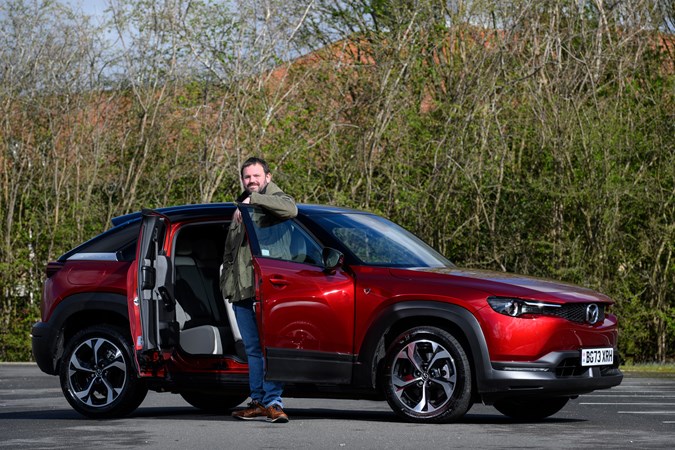
If you’re looking for a very alternative take on the small car, then you’ve come to the right long-term test. In this page we’re going to be spending some time with the MX-30 R-EV, which is an electric car with a smaller battery and a little rotary generator to keep the electricity topped up. We’re running it to see if it’s a good fit for our lifestyle, and if range anxiety really does disappear when petrol power returns.
Reports by Gareth Evans
Report 1: Welcome
We usher in life with a range extender plug-in hybrid, Mazda style…
Now here’s an interesting vehicle: a Mazda MX-30 R-EV. Decoding the name, it’s a small electric SUV with a tiny petrol engine used to generate power when the lithium-ion battery runs down.
But it’s no ordinary engine – it’s a rotary, which means instead of the rather complicated pistons and crankshafts in a normal car, it uses an oval engine with a curved triangle rotating inside, which means there are far fewer moving parts. In theory that means easier maintenance, but another advantage is that it’s easier to rev, with less inertia.
This isn’t Mazda’s first go at doing this, with several well-known sports cars of yore featuring the same design, but alas there’s a key difference here. While the RX-7s and later RX-8s of the ‘90s and 2000s had the engine sending power through a gearbox to the rear wheels, the MX-30 sends it to a battery that’s smaller than you get on the regular EV version, but still means a claimed 52 miles of range before petrol power kicks in. You can plug it in, too, meaning (in theory, at least) you’re getting the best of both worlds – petrol range, with EV running costs if you don’t go further than the battery range.
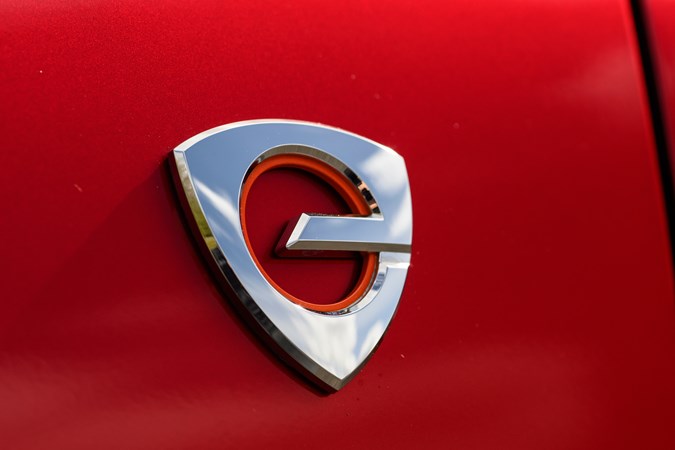
This energy is then sent to the front wheels. Sound complicated? I think it probably is, but I’m glad of the peace of mind of the additional range. I don’t have a fast charger at home, or any way to charge on my drive, so an EV doesn’t really work.
Its performance isn’t going to set the world alight, with a 0-62mph time of 9.1 seconds and a top speed of just 87mph, but then again, that’s easily quick enough to get around and the electrical assistance should help with over-taking.
However, I reckon it should steer fairly well for an EV-based vehicle. Its kerb weight is low for a car with a decent-sized battery, at just 1881kg including a 75kg driver.
Will the MX-30 be practical?
I’m not expecting anywhere near the usefulness of the far larger CX-60 I ran before here. This is a small car, and its diminutive boot and pokey rear cabin can’t be expected to pass muster as a family vehicle.
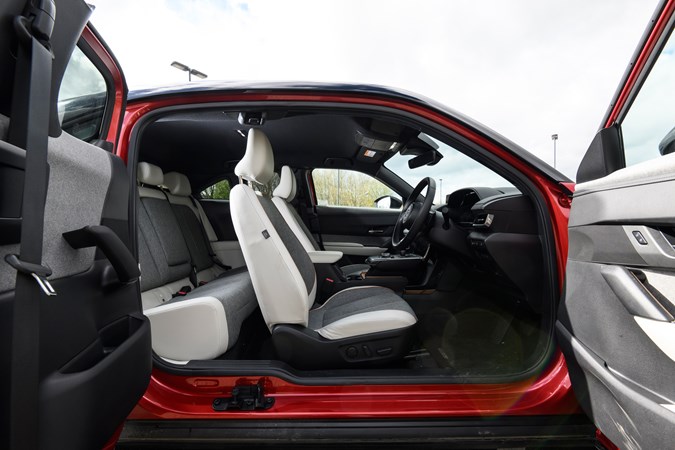
It has what used to be called ‘suicide’ rear doors, too, which open the opposite way to the fronts, as per the above. This is cool for the fact it harks back to the RX-8 sports car in its design, and equally less useful than back doors you can open independently of the front ones…
The boot capacity is 332 litres, which is roughly middling for a vehicle of these dimensions.
What about tech?
You can’t argue with the sheer array of technology on this car. Well, in fact you can, because much of it is voice-controlled, but I hope I won’t need to.
Anyway, highlights from the vast spec sheet include heated front seats and steering wheel, Android Auto, LED lights, keyless entry, a reversing camera, blindspot monitoring, active lane-keeping assist, automatic braking and a driver attention alert.
There’s also a neat app that comes with the car, allowing remote connectivity via a smartphone. That means you can warm it up and even defrost it on cold mornings, all from the comfort of your sofa, because the car remains locked until you get in it.
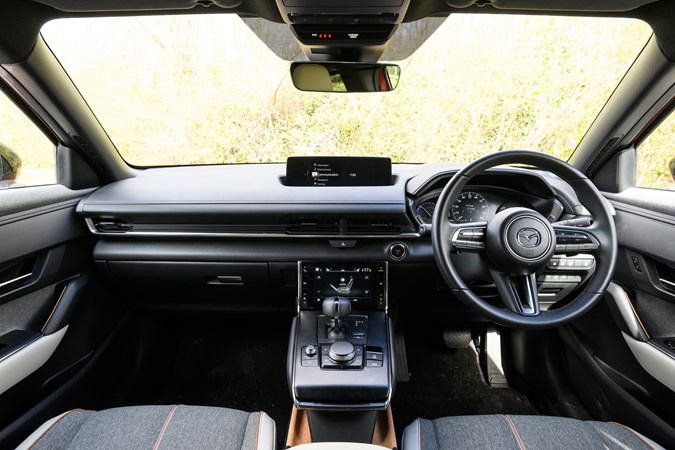
What spec is this Mazda MX-30?
The car we’re testing is in Exclusive-Line specification, which nets you all of the above safety tech alongside an 8.8-inch screen for the multimedia system, head-up display, a reversing camera and front and rear parking sensors.
The climate control works via a touchscreen below the multimedia screen, and I’m very curious to use this and find out if I miss physical buttons.
Its black 18-inch wheels are part of Exclusive-Line trim, along with an auto-dimming driver’s door mirror, tinted rear windows, heated front seats and keyless entry.
So, let’s see how we get on with this innovative new car…
Report 2: First impressions after 2500 miles
After a few thousand miles, Gareth’s found some bits he loves about the MX-30 R-EV, and some bits he doesn’t…
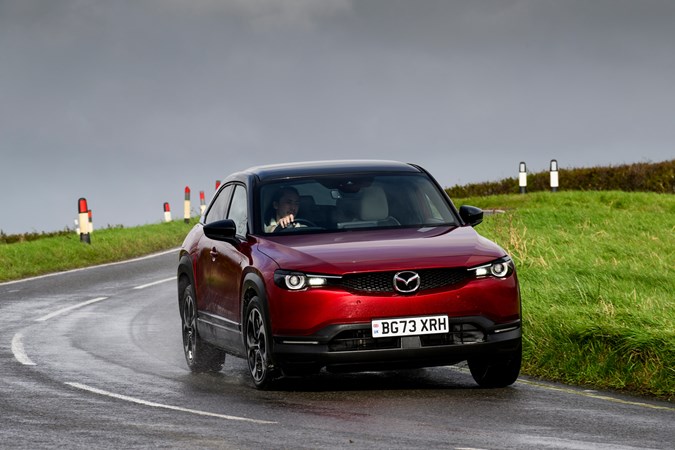
I’ve covered a few thousand miles in the MX-30 now, so it’s time for an update. Considering it’s based on an electric vehicle, I’ve been really impressed by the way it drives.
We’ve come to expect this from Mazdas, but it has wonderfully direct steering, balanced and responsive handling, and the ride quality is fantastic. This all adds up to a feeling of lightness that belies the 1881kg kerb weight. It’s a small car, and it feels like it, in the most complimentary way possible.
Its dimensions and design do mean it’s not a brilliant car for a family, though. Those rear doors hamper its practicality – with my driving position the gap between front and rear seats is barely big enough for a human to fit through, and if they can, the tiny tinted rear windows mean hardly any light makes its way back there. We’ve just got a puppy, and plugging him into the rear seatbelt has resulted in some travel sickness, simply because he can’t see out of the car. I can imagine on longer journeys a human would suffer a similar fate.
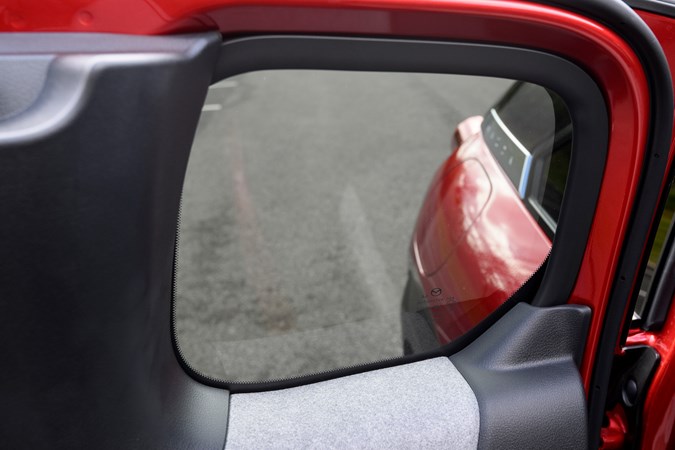
But otherwise, what a fantastic interior the MX-30 has. It’s a lovely design, with nicely laid out controls and loads of technology to play with. I was sceptical about the touchscreen-operated heating and ventilation adjustment, but actually because they get their own dedicated screen, it’s nowhere near as fiddly as other manufacturers’ systems where you need to flick through menus.
I’m a huge fan of the rotary control for the multimedia, too. It’s so intuitive you never have to think about looking at it to switch between the various features.
If you buy a Mazda MX-30 R-EV, prepare to get your hands dirty…
It’s fairly obvious that when you buy any plug-in car, you’ll need to manhandle the cables to plug it into a charging point, and if it’s raining it isn’t a pleasant experience. This isn’t new or unusual.
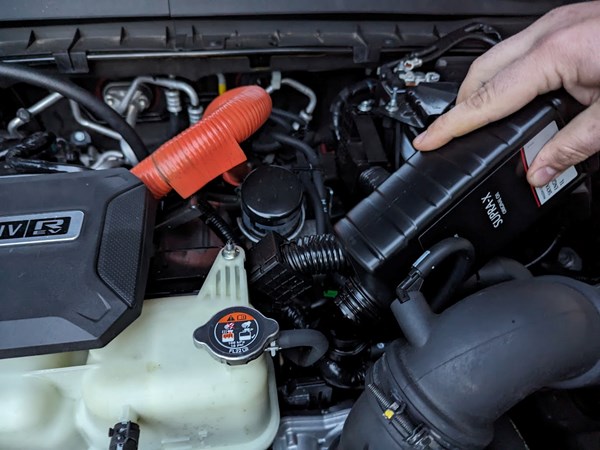
However, there aren’t many new cars out there today that require you to top up the oil within the first few thousand miles. I’ve done this twice on my MX-30, because a rotary power unit consumes a fair amount as it beds itself in, and the car presented me with a ‘top-up oil’ warning on the dash.
This is common for the design of engine, and your dealer will brief you accordingly, leaving a litre of oil in the boot, but it’s something you need to know about: this car is more hands-on than its rivals, and you’ll need to be prepared to open the bonnet and get familiar with the dipstick and oil filler.
Report 3: What’s the Mazda MX-30 R-EV like to drive?
We delve into the ride and handling to discover if this small SUV drives like a Mazda should
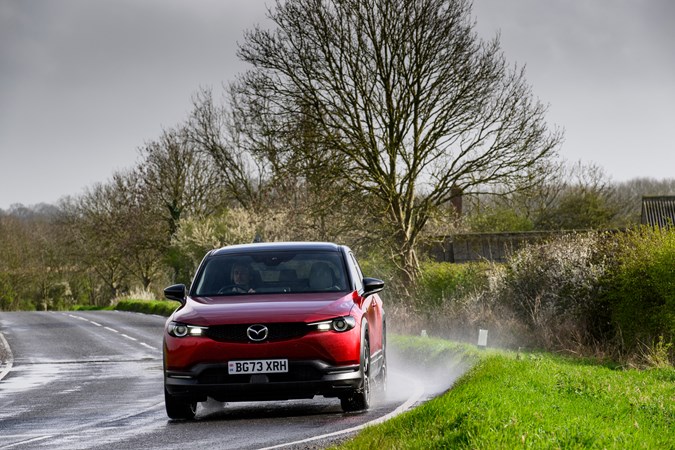
Mazda’s history is peppered with brilliant drivers’ cars. Both on the road and on the race track, the firm’s been seriously successful in the sporty driving stakes.
But the move to electrification presents a big challenge here, because electric vehicles are often extremely heavy thanks to their large batteries. This can mean their ride and handling suffer when compared to cars with internal combustion engines, because the springs and dampers need to work very hard and this can be at the expense of comfort or composed cornering.
But the MX-30 R-EV bucks this trend. Its handling and ride quality are exceptional, and the best compliment I can pay it is that it doesn’t feel like an electric car at all. The steering is nicely weighted and very responsive without ever feeling ‘darty’, while the suspension keeps the body’s movement predictable and controlled. It’s pleasing to see Mazda getting this so right where others have struggled.
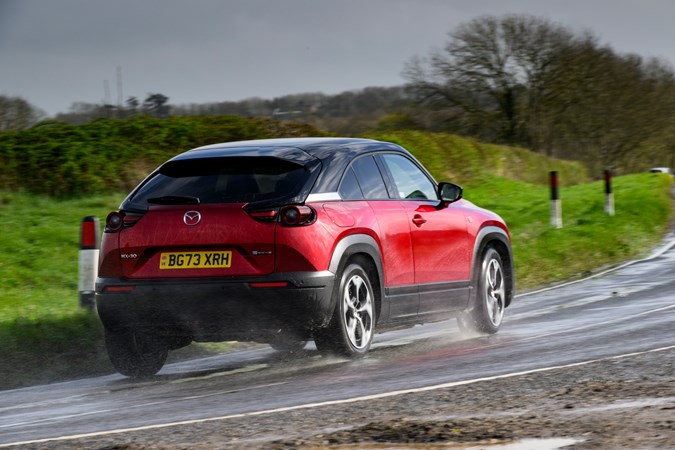
On the other hand, there are some bits about the R-EV’s design that I’m struggling with. The tiny rear window and huge B-pillar (the bodywork between front and rear windows) mean that checking your blindspot is almost impossible; sure, the ‘30 has blindspot detection to alert you with an orange dot in the door mirror if there’s a car hiding there, but sometimes you want to look with your own eyes to pre-empt events that will unfold in the future.
On my drive to work there’s a junction where I need to do precisely this, and the only solution is contorting my body into a rather unsafe position before twisting back and pulling away. If there was a lot of traffic it’d be a big problem.

The doors themselves are a bit of an oddity, too. Because the rears open backwards, you can only open them with the front doors. That’s not ideal, and neither is the front seatbelt being on the rear door, meaning you need to de-belt every time the back door is opened.
It’s a quirk that isn’t relevant if you’re only using the front seats, which perhaps is closer to this car’s use case, but it begs the question: why bother with rear doors at all? This could have been a two-door car with a far more practical view of the blindspot and hardly any penalty in terms of practicality.
Anyway, I’ve also been monitoring fuel usage recently, and have two things to report: it’s possible to get up to 60mpg if you’re regularly plugging the MX-30 into a chargepoint, but you’ll get closer to 31mpg if you never plug it in at all and rely on the rotary petrol engine. I don’t have a charging system at home, so guess what? I’m friends with my local petrol station attendant.
Update 4: The end of this leftfield line
It’s time to say goodbye to the quirky MX-30, but has it felt a good taste in our mouths?
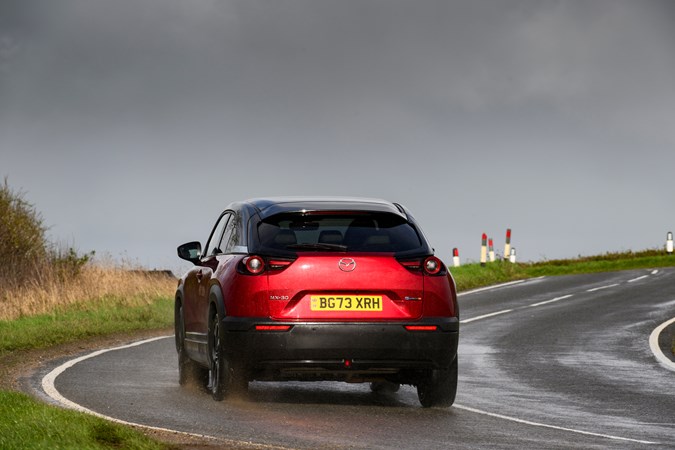
After 3500 miles, it’s time I said goodbye to the curious Mazda MX-30 R-EV. It’s been both fun and frustrating in equal measures running this left-field small SUV, which promises much on the spec sheet but delivers less as an ownership proposition for a lot of motorists.
My main bugbear with the car was its practicality. Sure, you could argue it’s not meant to be more than an occasional four-seater, but the rear is seriously cramped, dark and difficult to access. I just don’t understand Mazda’s decision to equip the car with backwards-facing doors, meaning you can’t open them independently of the fronts.
And furthermore, this brand-new car burnt its way through several litres of oil – I topped it up twice when prompted by a ‘low oil level’ warning – and while I understand that’s true of all rotary cars, in my opinion it’s simply unacceptable for a modern vehicle. Buyers nowadays rarely expect to have to get their hands dirty, and that’s particularly true of those buying small SUVs.
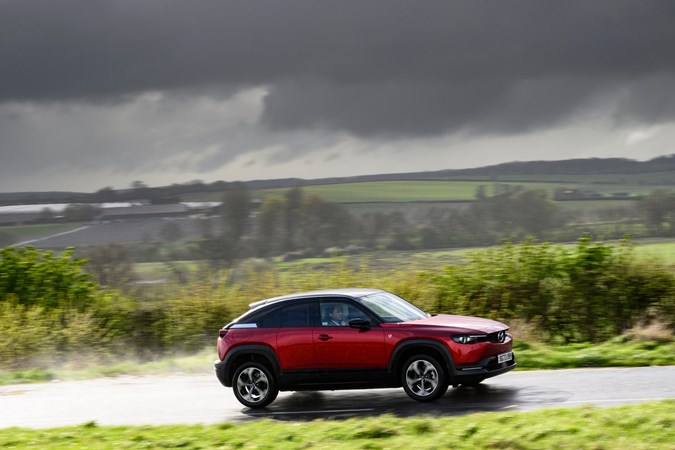
You’ll want to make sure you’ve got access to regular charging if you want low running costs, because without plugging it in you can expect around 31mpg in normal driving conditions.
Still, it hasn’t all been bad. The MX-30 is fantastic to drive, and its interior feels modern and well put together. I reckon it looks pretty good too, with Mazda’s signature design language really catching eyes in the firm’s excellent Soul Red paint.
I do wish it had wireless Android Auto like the CX-60 I ran before, because it’s quite a fiddle plugging the USB cable in every time. What’s more, the USB socket is located under the centre console, which again is somewhat annoying.

However, the seats were fabulously comfortable, and on the move the car is very quiet too, although occasionally the engine starts up and can sound slightly gruff.
My conclusion after spending a few months getting to know the MX-30 R-EV is that I can’t work out what or who it’s for. It doesn’t cut the mustard as a family car due to the practicality issues with the rear seats, has very little off-roading potential despite its SUV looks, and needs a hands-on approach to maintenance yet doesn’t deliver the kind of engagement you’d expect from a sportier car in return…
Mazda MX-30 R-EV: Scores on the doors
| Current mileage | 3565 |
| Real-world average fuel economy | 33.5mpg |
| Official combined fuel economy (WLTP figures) | 37.2mpg |
| Parkers ‘MPP’ (Miles Per Pound) calculation | 5.2-10.3 mpp |
| Dates tested by Parkers | February 2024-May 2024 |



